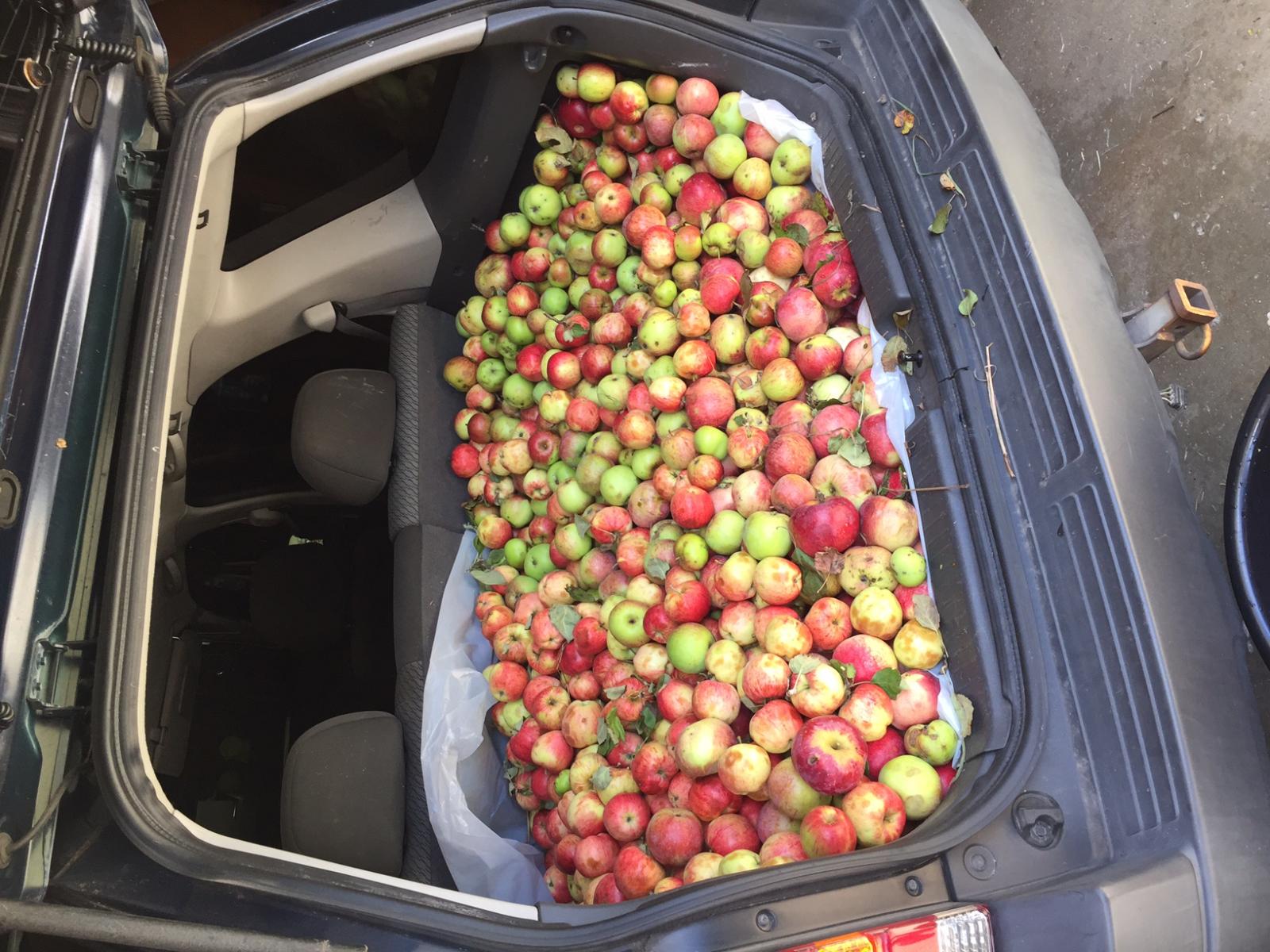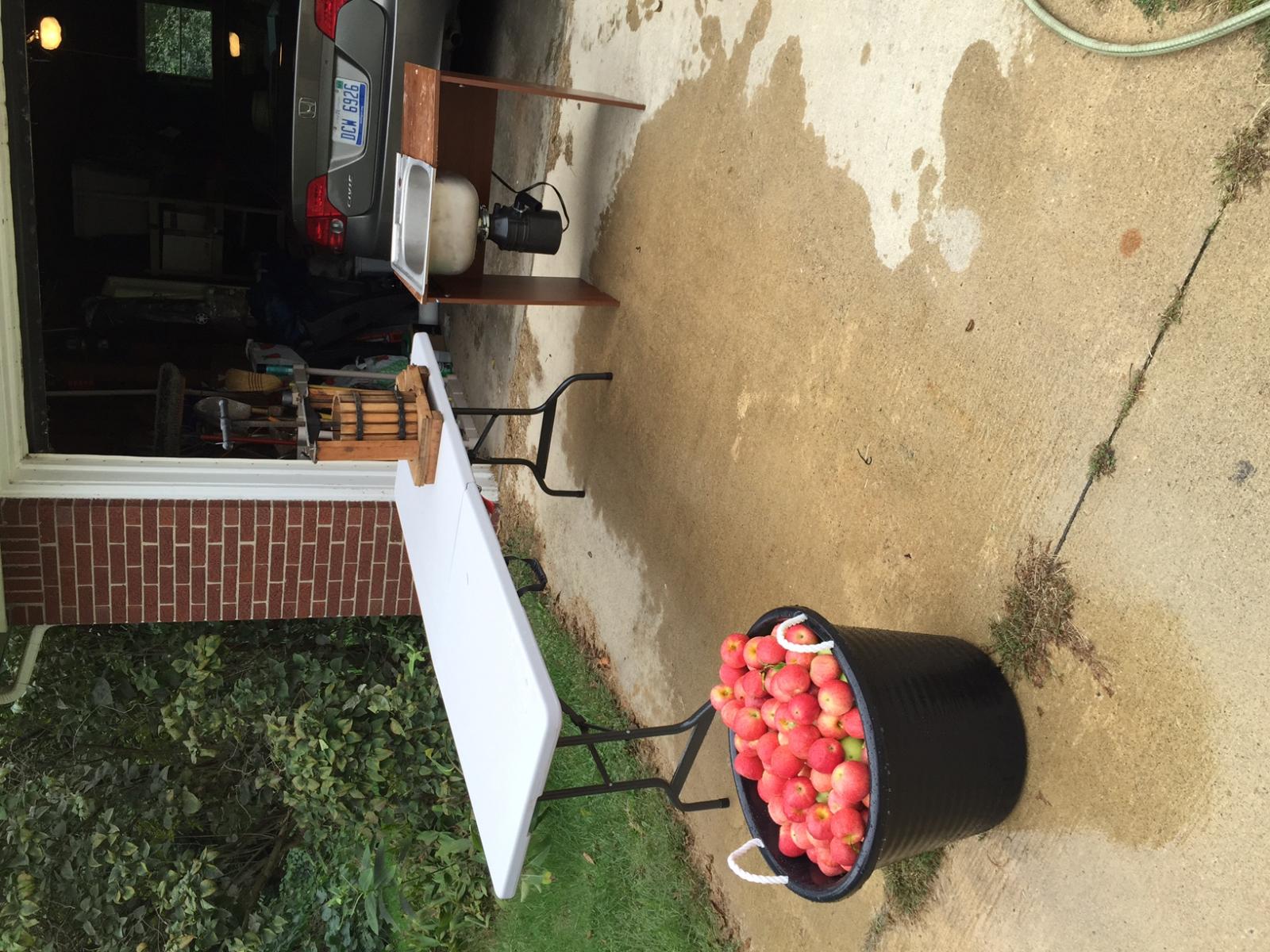I tried making cider for the first time this season, and I did a lot of research all over the place. There were so many questions and variables to consider, so below you will find the relatively cheapskate way of handling the process  Special thanks to the people who have been posting already here on homebrewtalk!
Special thanks to the people who have been posting already here on homebrewtalk!
Anyway, I figured I should share what I learned, since it seems like my adventures were successful - about 500 pounds of apples have turned into 6 fermenters happily bubbling away - so this is my attempt to put a lot of information in one spot. Thanks for reading!
First, some figures and terms: Apple volume is measured in bushels, which are roughly 40 pounds. One bushel is worth about 3 gallons of cider. I have laundry baskets that are labeled as 1.25 bushels, for what that's worth. For purposes of collecting apples, it seemed like the value for Rubbermaid containers was about 8-9 gallons per bushel.
Picking the apples: Pick a variety of apples (that taste good), some sweet, some tart. They should be ripe when you pick them. A good way to pick them is to lay down a tarp and shake a tree branch. Bruises won't matter since you're grinding them all up anyway. I discarded anything that was clearly infested or rotten. I bought those pole picker basket things, but I usually ended up just using the pole to shake the tree. The Internet says that trees are worth anywhere between 3 (dwarf) and 12 (whatever the opposite of dwarf is) bushels, but that's usually not all at once, because apples ripen at different times.
Side note: I have a bunch of apple trees that were planted in the 1940's. Many of them produced crap for apples. Apparently you can prune your trees to make them.. more fruitful again by cutting off 1/3 of unnecessary or dead branches every year for three years. They sell some kind of wound healer for trees to heal (?) the damage.
We ended up picking maybe 6-8 trees' decently ripe apples. 400 pounds in all (I did a two-bushel/5-gallon test batch earlier in the season with different apples). Image 1 shows the back of a Ford Escape partially full of the apples.
Grinding the apples: I'm pretty cheap, so, after a lot of research, I ended up buying an Insinkerator from Home Depot. I bought the second from the cheapest version for about $85 and the cord for about $12. I bought a stainless steel double kitchen sink (Craigslist - $25), sawzall-ed it in half, and cut out the footprint of the sink into an old desk (image2). My full setup is in image 3.
For the cloth, I bought some polyester tulle (try to avoid the glittery stuff) from JoAnn Fabric - I think it was about $5/yard and I ended up using 4 yards. Apparently you can wash this stuff, but I felt it was pretty beaten up after a 20-gallon day, so I just threw it out.
I ran the cord of the garbage disposal to a surge protector for some semblance of safety, and so that I could shut it off quickly with my foot in the event that it got clogged. There's a little fuse on the bottom that gets tripped when the disposal jams and overheats. It's about a 15 minute wait to cool off and get rocking again.
We found that cutting the apples into eighths or smaller prevented overheating. On day 3, with 2-3 people cutting, and me tossing apples in, we didn't trip the fuse. The garbage disposal handled the apple chunks about as quickly as I could load them. It was still going strong after 480 pounds of apples, 240 of which were ground in a 4-hour period. (It was cold - that might have helped). I used a wooden spoon to push the apples past the rubbery barrier thing.
What comes out is a nice mush (image 4).
The press: Here, I won't be very helpful. I found an ancient one in a relative's attic. Looks like it can hold a milk jug inside the basket. If it's full of apple mush, you can get about a gallon out of it. Anyway, the thing was filthy when I found it, so I soaked it in some Oxyclean dishwasher powder and water for a half hour, scrubbed it like mad, rinsed, gave it a vinegar rinse, and used a Star San rinse before pressing anything. I wouldn't mind building something at some point, but this one treated me well this season.
Getting ready to ferment: If you have a straining/filtration system, it would probably be nice to use. I just tried not to dump in any of the bottom settlings. I used potassium metabisulfite at a rate of 1/8 tsp per 5-gallon batch. I tried 1/4 teaspoon on my first batch and then pitched the yeast right after and got no fermentation for a couple of days. Had to re-pitch. It seems like the right balance was 1/8 tsp, wait 3-4 hours, then pitch already re-hydrated yeast.
The cider made from pretty ripe-when-picked apples was OG 1.050. When I picked less-ripe apples, it was 1.045. Those same apples a week later yielded OG 1.050 - I stored half in the fridge and half in plastic bags and didn't notice much difference. I added a couple pounds of corn sugar to some of the fermenters to boost ABV.
I think that's about it, but it's also almost 1:00 AM. What did I miss? Feel free to reply with any questions below.





Anyway, I figured I should share what I learned, since it seems like my adventures were successful - about 500 pounds of apples have turned into 6 fermenters happily bubbling away - so this is my attempt to put a lot of information in one spot. Thanks for reading!
First, some figures and terms: Apple volume is measured in bushels, which are roughly 40 pounds. One bushel is worth about 3 gallons of cider. I have laundry baskets that are labeled as 1.25 bushels, for what that's worth. For purposes of collecting apples, it seemed like the value for Rubbermaid containers was about 8-9 gallons per bushel.
Picking the apples: Pick a variety of apples (that taste good), some sweet, some tart. They should be ripe when you pick them. A good way to pick them is to lay down a tarp and shake a tree branch. Bruises won't matter since you're grinding them all up anyway. I discarded anything that was clearly infested or rotten. I bought those pole picker basket things, but I usually ended up just using the pole to shake the tree. The Internet says that trees are worth anywhere between 3 (dwarf) and 12 (whatever the opposite of dwarf is) bushels, but that's usually not all at once, because apples ripen at different times.
Side note: I have a bunch of apple trees that were planted in the 1940's. Many of them produced crap for apples. Apparently you can prune your trees to make them.. more fruitful again by cutting off 1/3 of unnecessary or dead branches every year for three years. They sell some kind of wound healer for trees to heal (?) the damage.
We ended up picking maybe 6-8 trees' decently ripe apples. 400 pounds in all (I did a two-bushel/5-gallon test batch earlier in the season with different apples). Image 1 shows the back of a Ford Escape partially full of the apples.
Grinding the apples: I'm pretty cheap, so, after a lot of research, I ended up buying an Insinkerator from Home Depot. I bought the second from the cheapest version for about $85 and the cord for about $12. I bought a stainless steel double kitchen sink (Craigslist - $25), sawzall-ed it in half, and cut out the footprint of the sink into an old desk (image2). My full setup is in image 3.
For the cloth, I bought some polyester tulle (try to avoid the glittery stuff) from JoAnn Fabric - I think it was about $5/yard and I ended up using 4 yards. Apparently you can wash this stuff, but I felt it was pretty beaten up after a 20-gallon day, so I just threw it out.
I ran the cord of the garbage disposal to a surge protector for some semblance of safety, and so that I could shut it off quickly with my foot in the event that it got clogged. There's a little fuse on the bottom that gets tripped when the disposal jams and overheats. It's about a 15 minute wait to cool off and get rocking again.
We found that cutting the apples into eighths or smaller prevented overheating. On day 3, with 2-3 people cutting, and me tossing apples in, we didn't trip the fuse. The garbage disposal handled the apple chunks about as quickly as I could load them. It was still going strong after 480 pounds of apples, 240 of which were ground in a 4-hour period. (It was cold - that might have helped). I used a wooden spoon to push the apples past the rubbery barrier thing.
What comes out is a nice mush (image 4).
The press: Here, I won't be very helpful. I found an ancient one in a relative's attic. Looks like it can hold a milk jug inside the basket. If it's full of apple mush, you can get about a gallon out of it. Anyway, the thing was filthy when I found it, so I soaked it in some Oxyclean dishwasher powder and water for a half hour, scrubbed it like mad, rinsed, gave it a vinegar rinse, and used a Star San rinse before pressing anything. I wouldn't mind building something at some point, but this one treated me well this season.
Getting ready to ferment: If you have a straining/filtration system, it would probably be nice to use. I just tried not to dump in any of the bottom settlings. I used potassium metabisulfite at a rate of 1/8 tsp per 5-gallon batch. I tried 1/4 teaspoon on my first batch and then pitched the yeast right after and got no fermentation for a couple of days. Had to re-pitch. It seems like the right balance was 1/8 tsp, wait 3-4 hours, then pitch already re-hydrated yeast.
The cider made from pretty ripe-when-picked apples was OG 1.050. When I picked less-ripe apples, it was 1.045. Those same apples a week later yielded OG 1.050 - I stored half in the fridge and half in plastic bags and didn't notice much difference. I added a couple pounds of corn sugar to some of the fermenters to boost ABV.
I think that's about it, but it's also almost 1:00 AM. What did I miss? Feel free to reply with any questions below.








